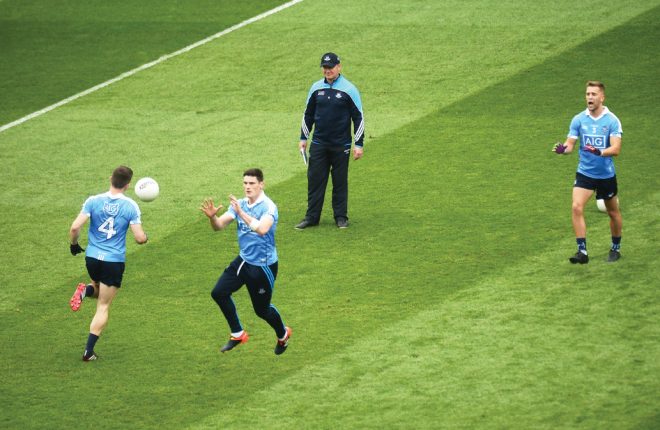
Jim Gavin’s Dublin teams always train with intensity
The best rugby teams (eg, All Blacks), soccer teams (Barcelona) have long trained with intensity.
In recent times under Jim Gavin, it is known, Dublin have trained with intensity and Donegal trained with intensity under Jim McGuinness. Others are beginning to, eg, Tyrone and Armagh.
The All Blacks believed that training with intensity developed the mindset to win. The approach used is that training, especially decision-making wise, should be harder than the game, eg, by throwing problems at players – unexpected events, forcing them to solve the problems. ‘Deal with it’, I call it.
In doing so, playing conditions must be replicated. If players are not over-extending themselves, little learning will result.
Intensity of preparation, where you get out of your comfort zone and extend yourself, conditions the brain and body to perform under pressure.
It lets peak performances become automatic and subconscious perfect performance practice develops the mindset to win.
This All Blacks phrase sums it up, “If you’re not going anywhere, you’re not going anywhere if you don’t train with intensity”.
Why? As Muhammad Ali said, “The fight is won or lost far away from witnesses – behind the lines, in the gym, out there on the road, well before I dance under the lights.”
Do not see training as the soft option. Effective training is intense, regular and repetitive and should be central to your culture if you want to succeed.
Training intensively isn’t new, eg, think Spartans or ‘elite’ modern special forces but training with intensity in your sport promotes personal growth.
In training with intensity, the psychological aspect is so vital – the use of randomness, unpredictability and constant questioning – combined with pace and physicality, in order to stress the brain and test decision-making capacity. It’s about trying to exercise decision-making in high stressed environments.
It’s role play for ‘real’. When we do it for real in competitive games, it’s automatic and subconsious, ie, we don’t think, we just do – habit really. Thus in games we’ll have clarity, accuracy, intensity.
It’s about the control of attention/focus. In pressure situations it’s very easy to shift conscously from a position of mental calm, clarity and inner strength into what’s called ‘Defensive Thinking’. We start to think about the outcome/survival and our ‘new’ perceptions create feelings of being overwhelming, tightening and tension.
This leads to overt aggression, shutting down and panic. We’ve gone from ‘carefree’ to ‘careless’. The situation gets to us. We make poor decisions. We choke.
‘Elite’ sports teams say we are H.O.T. – ‘Heated, Overwhelmed, Tense’ We’ve become the classic ‘Red Head’.
The opposite is the ‘Blue Head’, ie, the ability to maintain clarity, situational awareness, accurate analysis and good decision making under pressure.
Players can trust each other to deliver, to be flexible, be adaptable and on top of their game. Players can now see the ‘big picture’ (game system) and their attention is where it should be – in the NOW. Blue Heads remain on task and are not distracted.
Some ‘elite’ teams say being a Blue Head allows the team to A.C.T.
- A. Alternatives – looking at options, adapting, adjusting, overcoming.
- C. Consequences – understanding the risk/reward ratio of each alternative and making an accurate assessment of waht is needed.
- T. Task Behaviour – to stay on task and execute the tactics and strategy.
Performance under pressure is knowing how to ACT – ie, allowing yourself to win by following the process rather than being caught up in the outcomes.
Training with intensity begins by building technique and increasing intensity before introducing real pressure. Can training intensity be used in Gaelic sport?
(i) It makes no sense for Gaelic players to run 200, 400, 800 metres, etc, without a ball. These are tempo runs and do not overload the characteristic football quicker recovery between actions as players are not forced to catch their breath quicker.
There’s usually no stopping during these runs which are one directional with little change of pace and no change of activity, unlike Gaelic games which are multi-directional, much changing of pace and changes in activity.
(ii) Running trains the wrong systems for our games using oxygen to do the work, whereas by training with the ball in all types of ‘Gaelic games’ plus using shorter runs, eg, 10m, 15, 20, 25 up to 50m players are using their oxygen to recover without being breathless after repeated game sprints which are ‘working’ from energy supplied by the ‘speed endurace’ and ‘speed’ energy systems that this type of training delivers.
(iii) Running has a negative effect on fast twitch fibres as footballers need fast twitch muscles to do maximum explosive action.
So focusing attention on technique, increasing intensity and then adding pressure (mostly with the use of the ball) before finishing with reduced intensity and focus again on the technique is the full approach to training with intensity.
Repeat next session until it becomes automatic muscle memory and stored as memories in our subconscious.
The technique becomes powerfully embedded and the process (game sense) leaves players in a feeling of control.
This is called the ‘Unconscious Competence’ stage – the ‘elite’ stage of performance, as teams are able to stay on task, concentrate on the things they can control and stay in the moment. So, train with intensity.
Receive quality journalism wherever you are, on any device. Keep up to date from the comfort of your own home with a digital subscription.
Any time | Any place | Anywhere











